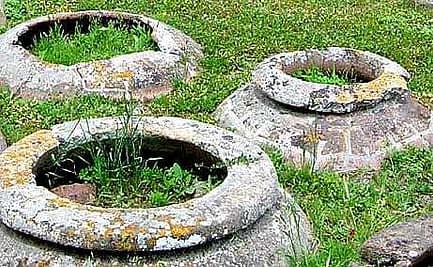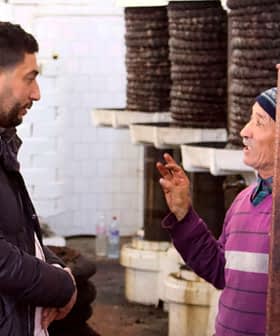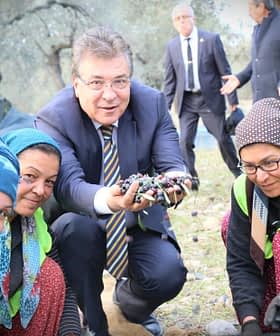The traditional olive harvesting system has gradually evolved since ancient times. Yet, what has not changed is the fact that, unfortunately, the olive juice also continues to gradually lose quality from the moment it is obtained, deteriorating every time it is handled. Just for the nostalgic, Andalusia still houses some antique mills that faithfully demonstrate all the stages the olive fruit is subjected to until its transformation into oil.
BY DESIDERIO VAQUERIZO GIL
The long pilgrimage by the olive from the moment it is harvested in the grove to the moment it is transformed into olive oil, progresses through various phases. Ancient civilizations established this journey and, in spite of the numerous technological advances, the essence of the process is maintained by the modern mills that obtain extra virgins of exceptional quality.
Harvest
Whenever possible, the Romans harvested the olive from the tree itself by either hand-picking them or shaking them off the tree. This was, and indeed still is, used for the highest quality olives or those to be pickled and consumed at the table.
If the harvest technique used was shaking, the olive pickers may have used blankets or allowed the olive to fall to the ground, constantly attempting to avoid damage to the fruit, because the quality of the juice depended largely on the integrity of the olive.
It would appear that the large scale harvests were so brutal that some olive producers only produced olives every two years, a circumstance which may have led to shortages or scarcity, even in those areas in which the olive groves were abundant. Not only the poor soil quality of a large part of the Mediterranean coastal countries contributed to this, but also overly aggressive pruning.
Storage and pressing
After being picked and when relatively clean, the olive had to be immediately transported to the place of pressing as the quality of the oil is directly proportionate to both the harvesting system and the time that passes between this and the milling, the storage method used and the pressing system. It needed to spend as little time as possible piled up in the mill in order to prevent deterioration, fermentation and oxidation, which would subsequently give rise to a very acid oil that easily became rancid. The Roman mills were very much aware of this and tended to work, as is current practice, round the clock, day and night (Pliny, Naturalis Historia XV, 10, 22 and 23). This author recommended heating the mills by burning the olive stones to fight off the freezing winter cold which, apart from making the work more miserable, made it difficult to extract the fat. But the rest of the Latin agronomists were against this practice as they believed that smoke, of any origin (even from lamps), could give the oil a bad taste. The solution they proposed was to build the mills facing South or to heat them using what we nowadays call “underfloor heating”, that is to say, the hot air coming from stoves (praefurnia) located outside the building, conducted under the ground (hypocausta) and through the walls by means of chambers (concamerationes).
The beginning of mechanised extraction
Oil extraction using mechanic techniques did not begin on a large scale until the Greco-Roman times. Before this, treading, crushing or pressing by large heavy stone rollers was used followed by wringing in fabrics, filtering and subsequently decanting the oil obtained, which was generally of very high quality.
The areas of the mill
In Andalusia, cradle of the former Baetica province, we know of numerous mills that faithfully documented the various stages of the process. Almost without exception, these were associated with the villae, although there are also some urban examples, such as the restored installation of Casa 2 de Munigua, Villanueva del Rey y Minas district, in the midst of the Seville mountains.
One of the best preserved is that excavated in the Antequera town of El Gallumbar (Málaga), which groups together all the spaces typical of a mill. Here, the pressing and extraction processes were –and are- essentially the same as those used nowadays:
- Cella olearia: this held the olive after being harvested in the grove. This name could also be used to describe the entire installation.
- Tabulatum: an intermediate storage space from which the olive was directly transported to the presses (Columella, De re rustica XII, 52, 3 – 5). The floor was sloped so that the alpechin (amurca) could be easily eliminated.
- Torcularium: the main pressing room, occupied by a joist or lever press. Nonetheless, the Mill also had a smaller manual press known as a trapetum.
- Lacus: deposit connected to the press into which the oil obtained flowed directly. In this, the olive juice underwent its first decantation process, necessary to separate the oil from the water, among other reasons. These deposits could be made of stone, brick, baked clay (like dolia) or lead. Specifically, in El Gallumbar it was made of masonry with a hydraulic coating and had a capacity of 2500 litres. Using these systems of progressive decantation, the oil (and heavier) water impurities fell to the bottom, in such a way that only the purest and best quality juice was obtained.
- Labrum: intermediate deposit, into which the oil was transferred for a new decantation phase. The one in Antequera could contain up to 650 litres.
- Dolia: large clay jugs in which the oil was provisionally stored, after being cleaned and purified, until transferred to the amphorae or the skins for transportation. Occasionally, it remained in these jugs for family consumption, as has continued to occur until practically the present day.
The process according to Columella
We are very familiar with all of this process, thanks to the documents left by the Latin agronomists. Among them, Lucio Junio Moderato, from Cadiz, who lived in the 1st century AD, particularly stands out with a description that could not be more expressive:
“As soon as the oils start to change colour and there are already some black olives but the majority are still white, it is advisable to handpick them in the good weather and, placing rush mats or reeds underneath, select and clean them; then, once carefully cleaned, immediately take them to the press, place them whole into new baskets and beneath the presses, to squeeze them for the minimum time possible… In the oil bodega, there should be three rows of churns, one to receive the top class oil, that is, the oil obtained from the first pressing, the second for the oil from the second pressing, and the third row for the third pressing; it is very important not to mix the second, and even less so the third, pressing with the first, because the oil from a press subjected to less pressure tastes far better” (Columella, De Re Rustica XII, 52, 10).
Olivarama articles also appear in Olivarama magazine and are not edited by the Olive Oil Times.









